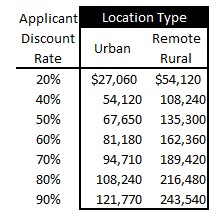The E-rate program is focused on supporting education. In honor of this important cause, I have prepared a simple math lesson designed to increase understanding about the availability of E-rate funding. Because I want students of all ages to understand, I will use round numbers to keep the math as simple and straight forward as possible. NOTE: the demand and availability of funding for libraries will not be included in this analysis.
Alright Math Masters, here we go!![]()
In 2013:
- 21,400 school districts applied for funding
- 52 million students were listed on E-rate applications
- $2.4 billion was made available via the E-rate funding cap
![]()
Question: How much funding is available per student?
Answer: $46.15 per student
Divide the total E-rate funding cap, $2.4 billion, by the number of students, 52 million. This gives us the average amount of funding that is available per student.
![]()
![]()
Question: How much funding is available per school district?
Answer: $112,150 per school district
Divide the total E-rate funding cap, $2.4 billion, by the number of applicants, 21,400. This gives us the average amount of funding that is available per applicant.
![]()
#####
There is about $46 per year in E-rate discounts available per K-12 student, or about $112,150 per school district. The FCC is currently considering ways in which to more effectively allocate those discounts. The E-rate program rules currently allocate these discounts among schools based on two factors:
- an applicant’s technology needs
- an applicant’s discount rate
Current rules dictate to schools that their highest priority should be recurring services, no matter how expensive or inefficient that they may be, or how far the school district’s on-campus infrastructure lags behind.
Funds For Learning has submitted a proposal to the FCC to change this priority system. We propose that discounts be spent towards each school’s highest priority needs and that they be rewarded for selecting the most cost-effective solutions.
Under the FFL proposal, E-rate discounts would be allocated based on three factors:
- an applicant’s location (with more money allocated for remote rural areas)
- an applicant’s discount rate
- an applicant’s student enrollment
Our proposal would allow schools to focus their E-rate discounts where they are needed the most.
##### ![]()
Question: What is the maximum amount of funding a 2,000 student, 20% discount rate, urban school district could request under the FFL proposal? Assume that the FCC doesn’t increase the E-rate funding cap.
Answer: $27,060
Using the Funds For Learning proposal, an urban school district with a discount rate of 20% and an enrollment of 2,000 students could request discounts up to $27,060 per year.
Urban school district calculation

![]()
Question: What is the maximum amount of funding a 2,000 student, 90% discount rate
school district could request under the FFL proposal? Assume that the FCC doesn’t increase the
E-rate funding cap.
Answer: $243,540
Using the Funds For Learning proposal, a remote rural school district with a discount rate of 90% and an enrollment of 2,000 students could request discounts up to $243,540 per year.
Urban school district calculation

![]()
Below is a table summarizing the range of maximum discounts that a 2,000 student school district could request. The total amount they could request varies based upon their discount rate and their location.
Maximum Discount Request of 2,000 Student School District
FFL Proposal, based on current E-rate Funding cap

If you do the math, you will see that there is only one way to enhance the effectiveness of the E-rate program. Under the FFL proposal, a school district can target its discounts towards the goods and services on the eligible services list that it deems most necessary.
